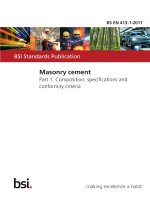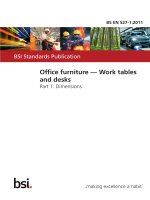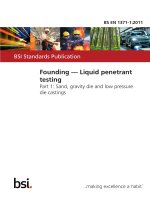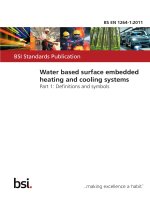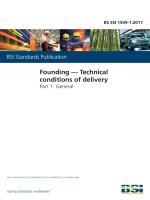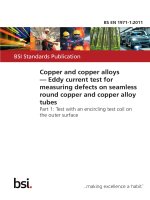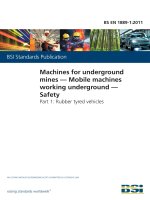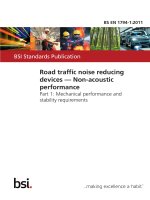Bsi bs en 61881 1 2011
Bạn đang xem bản rút gọn của tài liệu. Xem và tải ngay bản đầy đủ của tài liệu tại đây (907.94 KB, 50 trang )
BS EN 61881-1:2011
BSI Standards Publication
Railway applications —
Rolling stock equipment —
Capacitors for power
electronics
Part 1: Paper/plastic film capacitors
NO COPYING WITHOUT BSI PERMISSION EXCEPT AS PERMITTED BY COPYRIGHT LAW
raising standards worldwide™
BRITISH STANDARD
BS EN 61881-1:2011
National foreword
This British Standard is the UK implementation of EN 61881-1:2011. It is
identical to IEC 61881-1:2010. It supersedes BS EN 61881:1999, which is
withdrawn.
The UK participation in its preparation was entrusted by Technical Committee
GEL/9, Railway Electrotechnical Applications, to Subcommittee GEL/9/2,
Railway Electrotechnical Applications - Rolling stock.
A list of organizations represented on this committee can be obtained on
request to its secretary.
This publication does not purport to include all the necessary provisions of a
contract. Users are responsible for its correct application.
© BSI 2011
ISBN 978 0 580 60889 6
ICS 31.060.30; 45.060.01
Compliance with a British Standard cannot con fer immunity
from legal obligations.
This British Standard was published under the authority of the Standards
Policy and Strategy Committee on 31 March 2011.
Amendments issued since publication
Amd. No.
Date
Text affected
BS EN 61881-1:2011
EUROPEAN STANDARD
EN 61881-1
NORME EUROPÉENNE
February 2011
EUROPÄISCHE NORM
ICS 45.060
Supersedes EN 61881:1999
English version
Railway applications Rolling stock equipment Capacitors for power electronics Part 1: Paper/plastic film capacitors
(IEC 61881-1:2010)
Applications ferroviaires Matériel roulant Condensateurs pour électronique de
puissance Partie 1: Condensateurs papier et film
plastique
(CEI 61881-1:2010)
Bahnanwendungen Betriebsmittel auf Bahnfahrzeugen Kondensatoren für Leistungselektronik Teil 1: Papier-/Foliekondensatoren
(IEC 61881-1:2010)
This European Standard was approved by CENELEC on 2011-01-02. CENELEC members are bound to comply
with the CEN/CENELEC Internal Regulations which stipulate the conditions for giving this European Standard
the status of a national standard without any alteration.
Up-to-date lists and bibliographical references concerning such national standards may be obtained on
application to the Central Secretariat or to any CENELEC member.
This European Standard exists in three official versions (English, French, German). A version in any other
language made by translation under the responsibility of a CENELEC member into its own language and notified
to the Central Secretariat has the same status as the official versions.
CENELEC members are the national electrotechnical committees of Austria, Belgium, Bulgaria, Croatia, Cyprus,
the Czech Republic, Denmark, Estonia, Finland, France, Germany, Greece, Hungary, Iceland, Ireland, Italy,
Latvia, Lithuania, Luxembourg, Malta, the Netherlands, Norway, Poland, Portugal, Romania, Slovakia, Slovenia,
Spain, Sweden, Switzerland and the United Kingdom.
CENELEC
European Committee for Electrotechnical Standardization
Comité Européen de Normalisation Electrotechnique
Europäisches Komitee für Elektrotechnische Normung
Management Centre: Avenue Marnix 17, B - 1000 Brussels
© 2011 CENELEC -
All rights of exploitation in any form and by any means reserved worldwide for CENELEC members.
Ref. No. EN 61881-1:2011 E
BS EN 61881-1:2011
EN 61881-1:2011
Foreword
The text of document 9/1405/FDIS, future edition 1 of IEC 61881-1, prepared by IEC TC 9, Electrical
equipment and systems for railways, was submitted to the IEC-CENELEC parallel vote and was approved
by CENELEC as EN 61881-1 on 2011-01-02.
This European Standard supersedes EN 61881:1999.
Attention is drawn to the possibility that some of the elements of this document may be the subject of
patent rights. CEN and CENELEC shall not be held responsible for identifying any or all such patent
rights.
The following dates were fixed:
– latest date by which the EN has to be implemented
at national level by publication of an identical
national standard or by endorsement
(dop)
2011-10-02
– latest date by which the national standards conflicting
with the EN have to be withdrawn
(dow)
2014-01-02
Annex ZA has been added by CENELEC.
__________
Endorsement notice
The text of the International Standard IEC 61881-1:2010 was approved by CENELEC as a European
Standard without any modification.
In the official version, for Bibliography, the following notes have to be added for the standards indicated:
IEC 60077-1:1999
NOTE Harmonized as EN 60077-1:2002 (modified).
IEC 60077-2:1999
NOTE Harmonized as EN 60077-2:2002 (modified).
IEC 60110-1:1998
NOTE Harmonized as EN 60110-1:1998 (not modified).
IEC 60146-1-1:2009
NOTE Harmonized as EN 60146-1-1:2009 (not modified).
IEC 60384-14:2005
NOTE Harmonized as EN 60384-14:2005 (not modified).
IEC 60664-1:2007
NOTE Harmonized as EN 60664-1:2007 (not modified).
IEC 60831-1:1996
NOTE Harmonized as EN 60831-1:1996 (not modified).
IEC 60831-2:1995
NOTE Harmonized as EN 60831-2:1996 (not modified).
IEC 60871-1:2005
NOTE Harmonized as EN 60871-1:2005 (not modified).
IEC 60931-1:1996
NOTE Harmonized as EN 60931-1:1996 (not modified).
IEC 60931-2:1995
NOTE Harmonized as EN 60931-2:1996 (not modified).
IEC 61071
NOTE Harmonized as EN 61071.
IEC 61287-1:2005
NOTE Harmonized as EN 61287-1:2006 (not modified).
__________
BS EN 61881-1:2011
EN 61881-1:2011
Annex ZA
(normative)
Normative references to international publications
with their corresponding European publications
The following referenced documents are indispensable for the application of this document. For dated
references, only the edition cited applies. For undated references, the latest edition of the referenced
document (including any amendments) applies.
NOTE When an international publication has been modified by common modifications, indicated by (mod), the relevant EN/HD
applies.
Publication
Year
Title
EN/HD
Year
IEC 60068-2-14
-
Environmental testing Part 2-14: Tests - Test N: Change of
temperature
EN 60068-2-14
-
IEC 60068-2-20
-
Environmental testing EN 60068-2-20
Part 2-20: Tests - Test T: Test methods for
solderability and resistance to soldering heat
of devices with leads
-
IEC 60068-2-21
-
Environmental testing Part 2-21: Tests - Test U: Robustness of
terminations and integral mounting devices
EN 60068-2-21
-
IEC 60068-2-78
-
Environmental testing Part 2-78: Tests - Test Cab: Damp heat,
steady state
EN 60068-2-78
-
IEC 60269-1
-
Low-voltage fuses Part 1: General requirements
EN 60269-1
-
IEC 60695-2-11
-
Fire hazard testing EN 60695-2-11
Part 2-11: Glowing/hot-wire based test
methods - Glow-wire flammability test method
for end-products
-
IEC 60695-11-5
-
Fire hazard testing Part 11-5: Test flames - Needle-flame test
method - Apparatus, confirmatory test
arrangement and guidance
-
IEC 60721-3-5
-
EN 60721-3-5
Classification of environmental conditions Part 3: Classification of groups of
environmental parameters and their severities
- Section 5: Ground vehicle installations
-
IEC 61373
-
Railway applications - Rolling stock equipmentEN 61373
- Shock and vibration tests
-
IEC 62491
-
Industrial systems, installations and
EN 62491
equipment and industrial products - Labelling
of cables and cores
-
IEC 62497-1
-
Railway applications - Insulation
coordination Part 1: Basic requirements - Clearances and
creepage distances for all electrical and
electronic equipment
-
EN 60695-11-5
BS EN 61881-1:2011
61881-1 © IEC:2010
CONTENTS
1
Scope ...............................................................................................................................................7
2
Normative references.....................................................................................................................8
3
Terms and definitions ....................................................................................................................8
4
Service conditions. .......................................................................................................................13
4.1
5
Normal service conditions . ...............................................................................................13
4.1.1 Altitude . .................................................................................................................13
4.1.2 Temperature ..........................................................................................................13
4.1.3 Operating temperature with forced ventilation. .................................................13
4.2 Unusual service conditions . .............................................................................................13
Quality requirements and tests . ..................................................................................................14
5.1
Test requirements. .............................................................................................................14
5.1.1 General . ................................................................................................................14
5.1.2 Test conditions . ....................................................................................................14
5.2
Classification of tests. .......................................................................................................14
5.2.1 Routine tests . .......................................................................................................14
5.2.2 Type tests. .............................................................................................................15
5.2.3 Acceptance tests ..................................................................................................15
5.2.4 Summary of tests ..................................................................................................16
Capacitance and tan δ measurements (routine test) .....................................................16
5.3
5.3.1
5.3.2
5.3.3
Measuring procedure . ..........................................................................................16
Capacitance tolerances. ......................................................................................17
Loss requirements (tan δ ) . ..................................................................................17
5.4
Capacitor loss tangent (tan δ ) measurement (type test) . ............................................. 17
5.4.1 Measurements . .....................................................................................................17
5.4.2 Loss requirements . ..............................................................................................17
5.5
Voltage test between terminals . ......................................................................................17
5.5.1 General . ................................................................................................................17
5.5.2 Routine test ...........................................................................................................18
5.5.3 Type test . ..............................................................................................................18
AC voltage test between terminals and case . ................................................................18
5.6.1 Routine test ...........................................................................................................18
5.6.2 Type test . ..............................................................................................................19
5.6
5.7
5.8
5.9
5.10
Test of internal discharge device. ....................................................................................19
Sealing test . .......................................................................................................................19
Surge discharge test . ........................................................................................................19
Thermal stability test. ........................................................................................................20
5.10.1 General . ................................................................................................................20
5.10.2 Measuring procedure . ..........................................................................................20
5.11 Self-healing test. ................................................................................................................21
5.12 Resonance frequency measurement . .............................................................................21
5.13 Environmental testing . ......................................................................................................21
5.13.1 Change of temperature . ......................................................................................21
5.13.2 Damp heat, steady state . ....................................................................................21
5.14 Mechanical testing . ............................................................................................................22
5.14.1 Mechanical tests of terminals . ............................................................................22
BS EN 61881-1:2011
61881-1 © IEC:2010
5.14.2 External inspection . .............................................................................................23
5.14.3 Vibration and shocks. ...........................................................................................23
5.15 Endurance test . .................................................................................................................23
5.15.1 Conditioning of the units before the test . ..........................................................23
5.15.2 Initial capacitance and loss factor measurements . .......................................... 23
5.15.3 Endurance test . ....................................................................................................23
5.15.4 Final capacitance and tan δ measurement. .......................................................24
6
5.15.5 Acceptance criteria . .............................................................................................25
5.16 Destruction test . ................................................................................................................25
5.16.1 General . ................................................................................................................25
5.16.2 Test sequence for AC capacitors........................................................................26
5.16.3 Test sequence for DC capacitors .......................................................................27
5.17 Disconnecting test on internal fuses ................................................................................30
5.17.1 General . ................................................................................................................30
5.17.2 Disconnecting requirements ................................................................................30
5.17.3 Withstand requirements . .....................................................................................30
5.17.4 Test procedure . ....................................................................................................31
5.17.5 Capacitance measurement. .................................................................................32
5.17.6 Visual checking. ....................................................................................................32
5.17.7 Voltage test ...........................................................................................................32
5.18 Partial discharge measurements (optional type tests) . .................................................32
Overloads ......................................................................................................................................32
7
Safety requirements . ....................................................................................................................33
8
7.1 Discharge device . ..............................................................................................................33
7.2 Case connections . .............................................................................................................33
7.3 Protection of the environment ..........................................................................................33
7.4 Fire hazard . ........................................................................................................................33
7.5 Other safety requirements. ...............................................................................................33
Markings. .......................................................................................................................................34
8.1
9
Marking of the units ...........................................................................................................34
8.1.1 Rating plate ...........................................................................................................34
8.1.2 Data sheet . ............................................................................................................34
Guide to installation and operation . ...........................................................................................34
9.1
9.2
9.3
General . ..............................................................................................................................34
Choice of rated voltage . ....................................................................................................35
Operating temperature . .....................................................................................................35
9.3.1 Installation . ............................................................................................................35
9.3.2 Unusual cooling conditions. .................................................................................36
9.4
9.5
9.6
9.7
9.8
9.9
9.10
9.11
9.12
9.13
9.14
Special service conditions. ...............................................................................................36
Overvoltages . .....................................................................................................................36
Overload currents . .............................................................................................................36
Switching and protective devices . ...................................................................................37
Choice of creepage distance and clearance . .................................................................37
Connections . ......................................................................................................................37
Parallel connections of capacitors . ..................................................................................37
Series connections of capacitors. ....................................................................................37
Magnetic losses and eddy currents .................................................................................38
Guide for internal fuse and disconnector protection in capacitors............................... 38
Guide for unprotected capacitors . ...................................................................................38
BS EN 61881-1:2011
61881-1 © IEC:2010
Annex A (informative) Waveforms ...................................................................................................39
Annex B (normative) Operational limits of capacitors with sinusoidal voltages as a
function of frequency and at maximum temperature ( θ max ) . ........................................................41
Annex C (normative) Resonance frequency measuring methods – Examples ...........................43
Bibliography . ........................................................................................................................................45
Figure 1 – Destruction test arrangement . .........................................................................................27
Figure 2 – N source DC – type 1. ......................................................................................................29
Figure 3 – N source DC – type 2. ......................................................................................................29
Figure A.1a – Commutating waveform . ............................................................................................39
Figure A.1b – Commutating circuit example . ...................................................................................40
Figure A.1c – Damping capacitor for gate turn-off thyristors waveform . ......................................40
Figure A.1d – Damping circuit example . ..........................................................................................40
Figure B.1 – Supply conditions . ........................................................................................................41
Figure C.1 – Measuring circuit ...........................................................................................................43
Figure C.2 – Relation between the voltage across the capacitor and the supply frequency. .....44
Figure C.3 – Discharge current wave shape. ...................................................................................44
Table 1 – Maximum temperature of cooling medium for unlimited time. ......................................13
Table 2 – Summary of tests. ..............................................................................................................16
Table 3 – Test voltage between terminals . ......................................................................................17
Table 4 – Damp heat test ...................................................................................................................22
Table 5 – Testing the robustness of terminals.................................................................................22
Table 6 – Example of current-carrying capacities of screw terminals and bolts . ........................23
Table 7 – Endurance test ...................................................................................................................24
Table 8 – Destruction test as a function of type of safety system. ................................................25
Table 9 – Maximum permissible voltage ..........................................................................................32
BS EN 61881-1:2011
61881-1 © IEC:2010
–7–
RAILWAY APPLICATIONS –
ROLLING STOCK EQUIPMENT –
CAPACITORS FOR POWER ELECTRONICS –
Part 1: Paper/plastic film capacitors
1
Scope
This part of IEC 61881 applies to capacitors for power electronics intended to be used on
rolling stock.
The rated voltage of capacitors covered by this part is limited to 10 000 V.
The operating frequency of the systems in which these capacitors are used is usually up to
15 kHz, while the pulse frequencies may be up to 5 to 10 times the operating frequency.
It distinguishes between AC and DC capacitors.
They are considered as components mounted in enclosures.
NOTE This standard covers an extremely wide range of capacitor technologies for numerous applications:
overvoltage protection, DC and AC filtering, switching circuits, DC energy storage, auxiliary inverters, etc.
Examples are given in Clause 9.
The following are excluded from this standard:
–
capacitors for induction heat-generating plants operating at frequencies between 40 Hz and
24 000 Hz (see IEC 60110-1 and 60110-2);
–
capacitors for motor applications and the like (see IEC 60252-1 and IEC 60252-2);
–
capacitors to be used in circuits for blocking one or more harmonics in power supply
networks;
–
small AC capacitors as used for fluorescent and discharge lamps (see IEC 61048 and
IEC 61049);
–
capacitors for suppression of radio interference (see IEC 60384-14);
–
shunt capacitors for AC power systems having a rated voltage above 1 000 V (see
IEC 60871-1 and IEC 60871-2);
–
shunt power capacitors of the self-healing type for AC systems having a rated voltage up to
and including 1 000 V (see IEC 60831-1 and IEC 60831-2);
–
shunt power capacitor of the non self-healing type for AC systems having a rated voltage up
to and including 1 000 V (see IEC 60931-1 and IEC 60931-2);
–
series capacitors for power systems (see IEC 60143-1, IEC 60143-2 and IEC 60143-3);
–
coupling capacitors and capacitors dividers (see IEC 60358);
–
capacitors for applications requiring energy storage/high current discharge such as
photocopiers and lasers;
–
capacitors for microwave ovens;
–
capacitors for power electronics (see IEC 61071).
BS EN 61881-1:2011
–8–
2
61881-1 © IEC:2010
Normative references
The following referenced documents are indispensable for the application of this document. For
dated references, only the edition cited applies. For undated references, the latest edition of
the referenced document (including any amendments) applies.
IEC 60068-2-14, Environmental testing – Part 2-14: Tests. Test N: Change of temperature
IEC 60068-2-20, Environmental testing – Part 2-20: Tests. Test T: Test methods for
solderability and resistance to soldering heat of devices with leads
IEC 60068-2-21, Environmental testing – Part 2-21: Tests. Test U: Robustness of terminations
and integral mounting devices
IEC 60068-2-78, Environmental testing – Part 2-78: Tests. Test Cab: Damp heat, steady state
IEC 60269-1, Low-voltage fuses – Part 1: General requirements
IEC 60695-2-11, Fire hazard testing – Part 2-11: Glowing/hot-wire based test methods – Glowwire flammability test method for end-products
IEC 60695-11-5, Fire hazard testing – Part 11-5: Test flames – Needle-flame test method –
Apparatus, confirmatory test arrangement and guidance
IEC 60721-3-5, Classification of environmental conditions – Part 3: Classification of groups of
environmental parameters and their severities – Section 5: Ground vehicles installations
IEC 61373, Railway applications – Rolling stock equipment – Shock and vibration tests
IEC 62491, Industrial systems, installations and equipment and industrial products – Labelling
of cables and cores
IEC 62497-1, Railway applications – Insulation coordination – Part 1: Basic requirements –
Clearances and creepage distance for all electrical and electronic equipment
3
Terms and definitions
For the purposes of this document, the following terms and definitions apply.
3.1
capacitor element (or element)
indivisible part of a capacitor consisting of two electrodes separated by a dielectric
3.2
capacitor unit (or unit)
assembly of one or more capacitor elements in the same case with terminals brought out
3.3
capacitor bank
assembly of two or more capacitor units, electrically connected to each other
3.4
capacitor
general term used when it is not necessary to state whether reference is made to an element, a
unit or a capacitor bank
BS EN 61881-1:2011
61881-1 © IEC:2010
–9–
3.5
capacitor equipment
assembly of capacitor units and their accessories intended for connection to a network
3.6
capacitor for power electronics
power capacitor intended to be used in power electronic equipment and capable of operating
continuously under sinusoidal and non sinusoidal current and voltage
3.7
metal-foil capacitor (non self-healing)
capacitor in which the electrodes usually consist of metal foils separated by a dielectric, in the
event of a breakdown of the dielectric; the capacitor does not restore itself
3.8
self-healing metallized dielectric capacitor
capacitor, the electrodes of which are metallized (usually by evaporation); in the event of
dielectric breakdown, the capacitor restores itself
3.9
AC capacitor
capacitor essentially designed for operation with alternating voltage
NOTE AC capacitors may be used with DC voltage up to the rated voltage only when authorized by the capacitor
manufacturer.
3.10
DC capacitor
capacitor essentially designed for operation with direct voltage
NOTE DC capacitors may be used with a specified AC voltage only where authorized by the capacitor
manufacturer.
3.11
model capacitor
smaller unit which simulates a complete unit or element in an electrical test, without reducing
the severity of the electrical, thermal or mechanical conditions
NOTE The combined sum of stresses should always be considered, for instance the sum of temperature,
mechanical conditions and electrical stresses.
3.12
internal (element) fuse
device incorporated in the capacitor which disconnects an element or a group of elements in
the event of breakdown
3.13
safety devices
3.13.1
overpressure disconnector
disconnecting device inside a capacitor, designed to interrupt the current path in case of
capacitor failure
3.13.2
overpressure detector
device designed to detect abnormal increase of the internal pressure by an electrical
switch/signal and indirectly interrupt the current path
BS EN 61881-1:2011
– 10 –
61881-1 © IEC:2010
3.13.3
segmented metallization design
design of the metal layer over the dielectric shaped in a way to allow a small part of it to be
isolated in case of local short circuit or breakdown, in order to restore the full functionality of
the unit with a negligible loss of capacitance
3.13.4
special unsegmented metallization design
design of the metal layer over the dielectric shaped in a way that safe self-healing features
operating at a voltage up to U s guarantee the full functionality of the unit with a negligible loss
of capacitance
3.14
discharge device of a capacitor
a device which may be incorporated in a capacitor, capable of reducing the voltage between
the terminals practically to zero, within a given time, after the capacitor has been disconnected
from a network
3.15
rated AC voltage (U N )
maximum operating peak recurrent voltage of either polarity of a reversing type waveform for
which the capacitor has been designed
NOTE 1
The waveform can have many shapes. Examples are given in Annex A.
NOTE 2
The mean value of the waveform may be positive or negative.
NOTE 3
It is important to note that the rated AC voltage is not an r.m.s. value.
NOTE 4
Definitions used in this standard can be different from those of IEC 60077-1.
3.16
rated DC voltage (U NDC )
maximum operating peak voltage of either polarity but of a non-reversing type waveform, for
which the capacitor has been designed, for continuous operation
Damping capacitors, for gate turn-off thyristor (GTO) can be regarded as DC capacitors with a
ripple voltage equal to the rated DC voltage U NDC = U r .
In the case of reversal voltage, the use should be agreed between user and manufacturer.
NOTE If the reversal voltage is small (less than 10 %), the voltage waveform can be considered to be not
reversing. For test purposes, U NDC and U r should be increased by U, the reversal voltage.
3.17
ripple voltage (U r )
peak-to-peak alternating component of the unidirectional voltage
3.18
non-recurrent surge voltage (U s )
peak voltage induced by a switching or any other disturbance of the system which is allowed for
a limited number of times and for durations shorter than the basic period
3.19
insulation voltage (U i )
r.m.s. value of the sine wave voltage designed for the insulation between terminals of
capacitors to case or earth. If not specified, the r.m.s. value of the insulating voltage is equivalent to the rated voltage divided by
2.
BS EN 61881-1:2011
61881-1 â IEC:2010
11
3.20
maximum peak current (ẻ)
maximum peak current that can occur during continuous operation
3.21
maximum current (I max )
maximum r.m.s. current for continuous operation
3.22
maximum surge current (Ỵ s )
peak non-repetitive current induced by switching or any other disturbance of the system which
is allowed for a limited number of times, for durations shorter than the basic period
3.23
pulse frequency (f p )
repetition rate of periodic current pulses
3.24
current pulse width ( τ )
time of current flow during charging or discharging from one voltage value to another, of the
capacitor
NOTE
Pulse current waveform examples are shown in Annex A.
3.25
resonance frequency (f r )
lowest frequency at which the impedance of the capacitor becomes minimum
3.26
duty cycle
3.26.1
continuous duty
operation time such that a capacitor is at thermal equilibrium for most of the time
3.26.2
intermittent duty
discontinuous working or operation with variable loads which should be described in terms of
ON/OFF or HIGH/LOW periods with their durations
3.27
operating temperature
temperature of the hottest point on the case of the capacitor when in thermal equilibrium
3.28
lowest operating temperature ( θ min )
lowest temperature at which the capacitor may be energized
3.29
case temperature rise (Δ θ case )
difference between the temperature of the hottest point of the case and the temperature of the
cooling air
3.30
cooling-air temperature ( θ amb )
temperature of the cooling air measured at the hottest position of the capacitor, under steadystate conditions, midway between two units
BS EN 61881-1:2011
– 12 –
61881-1 © IEC:2010
If only one unit is involved, it is the temperature measured at a point approximately 0,1 m away
from the capacitor case and at two-thirds of the height from its base.
3.30.1
outlet fluid temperature for forced-cooled capacitors
temperature of the cooling fluid as it leaves the capacitor, measured at the hottest point
3.30.2
inlet fluid temperature for forced-cooled capacitors
temperature of the cooling fluid measured in the middle of the inlet fluid channel at a point not
influenced by the heat dissipation of the capacitor
3.31
maximum operating temperature ( θ max )
highest temperature of the case at which the capacitor may be operated
3.32
steady-state conditions
thermal equilibrium attained by the capacitor at constant output and at constant cooling-air
temperature
3.33
capacitor losses
active power consumed by a capacitor
NOTE Unless otherwise stated, the capacitor losses are understood to include losses in fuses and discharge
resistors forming an integral part of the capacitor.
At high frequency, the capacitor losses are predominantly due to losses in connections, contacts and electrodes.
3.34
tangent of the loss angle of a capacitor tan δ
ratio between the equivalent series resistance and the capacitive reactance of a capacitor at a
specified sinusoidal alternating voltage, frequency and temperature
tan δ = R esr ωC = tan d + R s ωC
tan d = dielectric loss factor
3.35
equivalent series resistance of a capacitor R esr
effective resistance which, if connected in series with an ideal capacitor of capacitance value
equal to that of the capacitor in question, would have a power loss equal to active power
dissipated in that capacitor under specified operating conditions
3.36
series resistance R s
effective ohmic resistance of the conductors of a capacitor under specified operating conditions
3.37
maximum power loss (P max )
maximum power loss with which the capacitor may be loaded at the maximum case
temperature
3.38
maximum frequency for maximum power loss and maximum current (f 2 )
frequency at which the maximum current ( I max) produces the maximum power loss ( P max) in the
capacitor. For explanation of ( f 2 ) see Annex B.
BS EN 61881-1:2011
61881-1 © IEC:2010
4
– 13 –
Service conditions
NOTE
See IEC 60077-1.
4.1
Normal service conditions
This standard gives requirements for capacitors intended for use in the following conditions:
4.1.1
Altitude
Not exceeding 1 400 m (IEC 62491 class A1).
NOTE The effect of altitude on convection cooling and external insulation should be taken into consideration, if the
altitude exceeds 1400 m. In this case the derating or a proper design shall be agreed between manufacturer and
user
4.1.2
Temperature
The climatic ambient temperatures are derived from IEC 60721-3-5 class 5k2 which has a
range from –25 °C to +40 °C.
Where ambient temperature lies outside this range, it shall be agreed between the user and the
manufacturer.
The upper limit of case temperature θ max at which the capacitor may be operated, shall be
chosen among the values 55 °C, 70 °C and 85 °C.
4.1.3
Operating temperature with forced ventilation
If capacitors are intended for forced cooling with a fluid medium, the operating temperature
conditions specified in 4.1.2 shall be observed.
The following Table 1 of preferred temperatures of cooling fluid shall be applied.
Table 1 – Maximum temperature of cooling medium for unlimited time
Inlet temperature
Outlet temperature
°C
°C
35
40
45
50
55
60
The lowest inlet temperature for the cooling fluid may be –25 °C.
There are two methods of specifying the upper temperature limit of the cooling medium using
either the inlet temperature or the outlet temperature.
Unless otherwise agreed, the choice of method shall be left to the capacitor manufacturer.
For the inlet method, the flow of cooling medium shall be specified.
4.2
Unusual service conditions
This standard does not apply to capacitors, whose service conditions are such as to be in
general incompatible with its requirements, unless otherwise agreed between the manufacturer
and the user.
BS EN 61881-1:2011
– 14 –
61881-1 © IEC:2010
Unusual service conditions require additional measurements, which ensure that the conditions
of this standard are complied with even under these unusual service conditions.
If such unusual service conditions exist then they shall be notified to the manufacturer of
the capacitor.
Unusual service conditions can include:
–
unusual mechanical shocks and vibrations,
–
cooling water with corrosive or obstructing particles (sea water, very hard water),
–
corrosive and abrasive particles in the cooling air,
–
dust in the cooling air, particularly if conductive,
–
explosive dust or gas,
–
oil or water vapour or corrosive substances,
–
nuclear radiation,
–
unusual storage or transport temperature,
–
unusual humidity (tropical or subtropical region),
–
excessive and rapid changes of temperature (more than 5 °C/h) or of humidity (more than
5 %/h),
–
service areas higher than 1 400 m above sea level,
–
superimposed electromagnetic fields,
–
excessive overvoltages, as far as they exceed the limits given in Clause 6,
–
airtight (poor change of air) installations.
5
Quality requirements and tests
5.1
5.1.1
Test requirements
General
This subclause gives the test requirements for capacitor units.
5.1.2
Test conditions
Unless otherwise specified for a particular test or measurement, the temperature of the
capacitor dielectric shall be in the +5 °C to +35 °C range.
If corrections are necessary, the reference temperature shall be +20 °C, unless otherwise
agreed between the manufacturer and the user.
NOTE It may be assumed that the dielectric temperature is the same as the ambient temperature, provided that
the capacitor has been left in an unenergized state, in a constant ambient temperature, for an adequate period of
time in order to reach thermal equilibrium.
The AC tests and measurements shall be carried out with a sinusoidal voltage of 50 Hz or
60 Hz, unless otherwise specified.
5.2
Classification of tests
The test are classified as routine test, type tests and acceptance tests as follows:
5.2.1
Routine tests
Routine tests are the following:
BS EN 61881-1:2011
61881-1 © IEC:2010
– 15 –
a) sealing test (5.8);
b) external inspection (5.14.2);
c) voltage test between terminals (5.5.2);
d) voltage test between terminals and case (5.6.1);
e) capacitance and tan δ measurements (5.3);
f)
test of internal discharge device (5.7);
Routine tests shall be carried out by the manufacturer on every capacitor before delivery.
At his request, the user shall be supplied with a certificate detailing the results of such tests.
The sequence of the tests is as indicated.
5.2.2
Type tests
Unless otherwise specified, every capacitor sample to which it is intended to apply the type test
shall first have withstood satisfactorily the application of all the routine tests.
Type tests are the following:
a) voltage test between terminals (5.5.3);
b) voltage test between terminals and case (5.6.2);
c) surge discharge test (5.9);
d) self-healing test (5.11);
e) environmental testing (5.13);
f)
mechanical testing (5.14);
g) capacitor tangent of the loss angle (tan δ ) measurement (5.4);
h) thermal stability test (5.10);
i)
test of internal discharge device (5.7);
j)
resonance frequency measurement (5.12);
k) endurance test between terminals (5.15);
l)
disconnection test on fuses (5.17);
m) destruction test (5.16).
Type tests are intended to prove the soundness of the design of the capacitor and its suitability
for operation under the considerations detailed in this standard.
The type tests shall be carried out by the manufacturer, and the user shall, on request, be
supplied with a certificate, detailing the results of such tests.
These tests shall be made upon a capacitor of a design identical to that of the capacitor under
contract, or on a capacitor of a design that gives during the test the same or more severe test
conditions.
It is not essential that all type tests be carried out on the same capacitor sample. The choice is
left to the manufacturer.
5.2.3
Acceptance tests
The routine and/or type test, or some of them, may be carried out by the manufacturer, on
agreement with the user.
BS EN 61881-1:2011
61881-1 © IEC:2010
– 16 –
The number of samples that may be subjected to such repeat tests, the acceptance criteria, as
well as permission to deliver any of these units shall be subject to agreement between the
manufacturer and the user, and shall be stated in the contract.
5.2.4
Summary of tests
Table 2 lists the type and routine test for capacitor units.
Table 2 – Summary of tests
5.3
5.3.1
Test item
Type
Routine
1
Capacitance and tanδ measurements
-
5.3
2
Capacitor loss tangent (tanδ ) measurement
5.4
-
3
Voltage test between terminals
5.5.3
5.5.2
4
Voltage test between terminals and case
5.6.2
5.6.1
5
Test of internal discharge device
5.7
5.7
6
Sealing test
-
5.8
7
Surge discharge test
5.9
-
8
Thermal stability test
5.10
-
9
Self-healing test
5.11
-
10
Resonance frequency measurement
5.12
-
11
Environmental testing
5.13
-
12
Mechanical testing
5.14
-
13
External inspection
-
5.14.2
14
Endurance test
5.15
-
15
Destruction test
5.16
-
16
Disconnecting test on fuses
5.17
Capacitance and tan δ measurements (routine test)
Measuring procedure
The capacitance and tan δ shall be measured at a voltage and at a frequency chosen by the
manufacturer.
The method used shall not include errors due to harmonics or to accessories external to the
capacitor to be measured, such as reactors and blocking circuits in the measuring circuit.
The accuracy of the measuring method shall be given and shall be better than 0,2 % for
capacitance and 10 % for tan δ but not necessarily better than 1 × 10 –4 if the measurement is
made at 50-60 Hz.
NOTE
For capacitors in the milliFarad range a lower accuracy may be appropriate.
The capacitance measurement shall be carried out after the voltage test between terminals
(see 5.5).
For capacitors with internal fuses, capacitance measurement shall also be made before the
voltage tests.
BS EN 61881-1:2011
61881-1 © IEC:2010
5.3.2
– 17 –
Capacitance tolerances
If not otherwise specified, the capacitance measured shall not differ from the rated capacitance
by more than –10 % to +10 %.
Loss requirements (tan δ )
5.3.3
The requirements regarding capacitor losses may be agreed upon between the manufacturer
and the user.
NOTE The manufacturer should, on agreement, furnish curves or tables showing the capacitor losses under
steady-state conditions at rated output as a function of ambient temperature within the temperature category.
5.4
Capacitor loss tangent (tan δ ) measurement (type test)
5.4.1
Measurements
The following measurements shall be made:
5.4.1.1
AC capacitors
The capacitor losses (tan δ ) shall be measured at the end of the thermal stability test (see
5.10).The measuring voltage end frequency may be agreed upon between the manufacturer
and the user.
5.4.1.2
DC capacitors
The measurement shall be carried out at a frequency in the range of 50 Hz to 60 Hz at the
ripple voltage ( U r ) divided by 2 2 .
NOTE The losses in the electrodes, connections, leads and terminals are functions of the frequency and can be
calculated.
5.4.2
Loss requirements
The value of tan δ measured in accordance with 5.4.1 shall not exceed the value declared by
the manufacturer, or the value agreed upon between the manufacturer and the user.
5.5
5.5.1
Voltage test between terminals
General
Tests shall be carried out according to the following Table 3:
Table 3 – Test voltage between terminals
AC capacitors
DC capacitors
All types
Non-self-healing
Self-healing
AC test voltage r.m.s. value
1,5 U N
–
–
DC test voltage
2,15 U N
2 U NDC
1,5 U NDC
The test voltage indicated in Table 3 can be reduced if capacitors are intended for intermittent
duty (see 3.26.2) or for short service duration; the new values shall be agreed upon between
the manufacturer and the user. For capacitors directly connected to the line supply, the test
BS EN 61881-1:2011
61881-1 © IEC:2010
– 18 –
voltage between terminals may be increased on agreement between the manufacturer and the
user.
NOTE
5.5.2
The AC test voltage may be at 50 Hz or 60 Hz.
Routine test
Every capacitor shall be subjected for 10 s to either test of 5.5.1 at ambient temperature. The
choice is left to the manufacturer. During the test, neither puncture nor flashover shall occur.
Self-healing breakdowns are permitted.
The duration may be reduced to 2 s provided the voltage is increased by 10 %.
This is to be agreed between the manufacturer and the user.
In the case of units with all elements in parallel, operation of internal element fuse(s) is
permitted provided the capacitance tolerances are still met.
NOTE
5.5.3
If necessary, this test can be repeated one more time only.
Type test
The capacitor shall be subjected for 1 min to either test of 5.5.1.
The choice is left to the manufacturer.
After the test voltage between terminals the capacitance and tan δ shall be measured.
5.6
5.6.1
AC voltage test between terminals and case
Routine test
Units having all terminals insulated from the case shall be subjected for 10 s to a voltage
applied between the terminals (joined together) and the case.
The test voltage values are the following:
U t, case = 2 U i + 1 000 V or 2 000 V whichever is the highest value,
where U i is the insulation voltage.
The duration may be reduced to 2 s provided the voltage is increased by 10 %.
This is to be agreed between the manufacturer and the user
The insulating voltage of the capacitor shall be specified by the user. The insulation voltage is
equal to the rated voltage of the capacitor, divided by
2 , unless otherwise specified.
During the test, neither puncture nor flashover shall occur. The test shall be performed even if
one of the terminals is intended to be connected to the case in service.
Units having one terminal permanently connected to the case shall not be subjected to this
test.
NOTE 1 If the capacitor (with metal case) is equipped with an external overpressure detector, the terminals of the
detector should be joined together and connected to the case.
